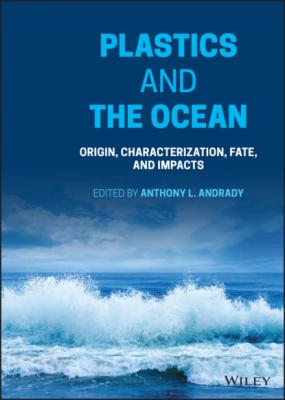Plastics and the Ocean. Группа авторов
Читать онлайн.| Название | Plastics and the Ocean |
|---|---|
| Автор произведения | Группа авторов |
| Жанр | Химия |
| Серия | |
| Издательство | Химия |
| Год выпуска | 0 |
| isbn | 9781119768418 |
Note:
a Not experimentally derived, rather estimated from ECOSAR program.
b 24‐hour exposure.
> means the LD50 is above the water solubility; >>> means the LD50 is well above this measured concentration of water hardness in toxicity test water.Red shades indicate >5 log K ow (concern for bioaccumulation/biomagnification) or LD50 < 1 (concern for acute aquatic toxicity).
These two mechanisms influence the modeling of additive transport, leading to another comparison of seemingly conflicting results. Koelmans et al. (2016) concluded that most plastic additives in the ocean had already reached equilibrium between seawater and plastic debris. This interpretation was based on the estimate that 80–90% of plastic in the ocean has been there for two to four years, much longer than it takes free additives to reach equilibrium between the plastic and water. In contrast, Kwon et al. (2017) concluded that plastic additives intentionally added may not ever attain equilibrium between plastic and water in the marine environment. Both perspectives can be correct – certain additives especially those that have already escaped plastics (e.g. BFRs, APs, BPA) may already be at sorption equilibrium with plastics in the ocean. Incorporating both perspectives into models will make for the most accurate real‐world estimates of plastic additive mass balance and fluxes.
2.3.3 The Complexity of Multiple Compartments
The ocean consists of multiple compartments, not just plastic and water, that can carry additive chemicals (Figure 2.2). Some of the dynamic processes that determine the transport and fate of plastic additives in the marine environment, and the role of the host plastic, are presented in Figure 2.3. For the complete understanding of chemical additive transport and fate in the ocean, all environmental compartments must be considered, including air, soil, sediments, freshwater, seawater, and biological matter. For this reason, several physicochemical properties beyond K pw, water solubility, and K ow are important. Vapor pressure, Henry’s constant, octanol–air partition coefficient (K oa), and the organic carbon partition coefficient (K oc) also dictate the transport and fate of plastic additives, especially exchanges between various compartments (Net et al. 2015).
Figure 2.3 Transport and fate of hydrophobic organic chemicals to/from marine plastic particles, seawater, and biota.
Source: Adapted from Kwon et al. (2017).
2.3.3.1 Transport of Plastic Additives to/From Marine Sediment
Marine sediments are thought of as the final sink compartment for plastic additives and often have the highest concentrations among all compartments. Sources of plastic additives to sediment include leaching from sunken plastic debris into the sediment, partitioning from overlying water or pore water, and settlement of sinking organic material (Figure 2.2). Resuspension of sediment constituents into the water column from bioturbation or currents can transport additives back to the water column (Gallo et al. 2018). Additives with low polarity and high K oc values likely accumulate in sediment. K oc values are commonly correlated with hydrophobicity or lipophilic properties, measured by K ow.
2.3.3.2 Transport of Plastic Additives to/From Marine Biota
Marine organisms may be exposed to plastic additives via inhalation, dermal sorption, or ingestion of plastics or the free additives. Significant debate exists in the scientific literature whether the dominant route of exposure is from additives leaching from ingested plastics in the gut or from direct exposure to additives in water or prey. Early studies argued that plastic ingestion is a dominant exposure route since a wide range of marine animals eat plastics, and experimental studies have proven this mechanism in laboratory animals (Browne et al. 2013; GESAMP 2015; Rochman et al. 2013; Tanaka et al. 2013; Teuten et al. 2009). Other studies argue that the contribution of plastics to the bioaccumulation of additives in marine organisms is likely small; rather bioaccumulation is predominantly from ingesting prey tissues that already contain these compounds (Bakir et al. 2014; Clukey et al. 2018; Koelmans et al. 2014, 2016; Rochman et al. 2013; Zarfl and Matthies 2010). In fact, ingesting “clean” plastics reduces HOC concentrations in the body by sorption of the compounds to plastic as it moves through the gut and elimination via feces (Koelmans et al. 2014). Koelmans et al. (2016) provides a critical review of the literature concerning the role of plastic as a carrier/vector of additives and concluded that for the majority of marine habitats, bioaccumulation of HOCs from microplastic is likely overwhelmed by uptake via natural diet. However, in some cases, exposure to additives by the ingestion of plastic may be substantial if the amount of additives in ingested plastic is sufficiently larger than the amount in other diet items (Koelmans et al. 2016).
